中国文化英语翻译
中国文化的英语

中国文化的英语中国文化是全球最古老的文化之一,自古以来就吸引着众多外国学者和游客。
近年来,随着全球化的发展,人们更加开放地观察和研究中国文化,更多的中国文学和文化的元素正在被引入英语语言和文化传播中。
“中国文化”一词本身就被英文化,也就是“Chinese culture”,开始被广泛使用。
它体现了中国历史、文明、习俗等传统文化,也象征着中国早期文化融入现代文明的历程。
通过各种翻译和英语表达,中国文化中的观念也得以实现了英语转换。
比如,“和谐”,一个中国传统文化的重要观念,被英语翻译为“harmony”能够更好的传达出它的含义。
英文中也出现了很多跟中国相近的文化元素,比如“禅”,翻译为“Zen”,用来形容一种境界;“把玩”,翻译为“fiddling”,表示在一个物理对象上进行的心灵游戏;“竹林七贤”,翻译为“the Seven Sages of the Bamboo Grove”,来描述一系列古代典型的文人。
此外,中国文化还影响了英文语法,诸如“它画一幅画”就像中文一样,用it painted a picture来表达;“你们都喜欢看电视”像中文一样用you all like watching TV来表达等。
当然,主要是句法结构上,以及词汇上中国文化对英文有较为明显的影响。
另一方面,中国文化也提供了英语学习者有效的参考。
例如,中国的成语提供了英语学习者全新的词汇,比如“望子成龙”wish one child has a dragon-like future。
它也丰富了英语学习者的语言表达范围,比如道出一个简洁而准确的句子,如“事事如意”everything goes as planned。
中国文化也深深影响了文学艺术,与英语文学艺术交融,形成了一种新的英语文化,其中融入了中国文化的元素,比如中国风筝、冰糕、竹子的描写,“李白”等英文版的中国人名,“龙”以及其他如“山水”、“烟花”等中国文化的符号。
高中英语 高考英语作文有关中国传统文化的范文4篇带中文翻译
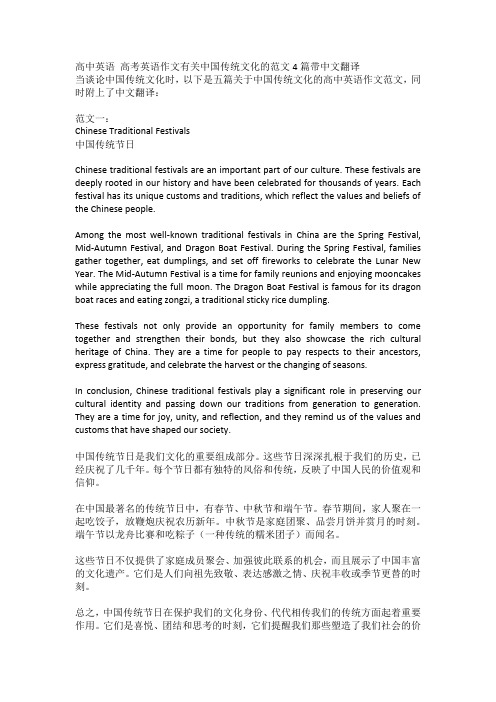
高中英语高考英语作文有关中国传统文化的范文4篇带中文翻译当谈论中国传统文化时,以下是五篇关于中国传统文化的高中英语作文范文,同时附上了中文翻译:范文一:Chinese Traditional Festivals中国传统节日Chinese traditional festivals are an important part of our culture. These festivals are deeply rooted in our history and have been celebrated for thousands of years. Each festival has its unique customs and traditions, which reflect the values and beliefs of the Chinese people.Among the most well-known traditional festivals in China are the Spring Festival, Mid-Autumn Festival, and Dragon Boat Festival. During the Spring Festival, families gather together, eat dumplings, and set off fireworks to celebrate the Lunar New Year. The Mid-Autumn Festival is a time for family reunions and enjoying mooncakes while appreciating the full moon. The Dragon Boat Festival is famous for its dragon boat races and eating zongzi, a traditional sticky rice dumpling.These festivals not only provide an opportunity for family members to come together and strengthen their bonds, but they also showcase the rich cultural heritage of China. They are a time for people to pay respects to their ancestors, express gratitude, and celebrate the harvest or the changing of seasons.In conclusion, Chinese traditional festivals play a significant role in preserving our cultural identity and passing down our traditions from generation to generation. They are a time for joy, unity, and reflection, and they remind us of the values and customs that have shaped our society.中国传统节日是我们文化的重要组成部分。
英语畅谈中国文化unit2课文翻译

用英文畅谈中国文化unitChinese Culture中国文化The wisdom of confucius discuss«孔子智慧»探讨的是The most important school of Chinese philosophy中国哲学最为重要的学派——Confucianism儒家学派——with the focus on重点探究its Core Concepts Ren and Li.其核心思想“仁”和“礼”Ren means goodness or benevolence and Li means ritual or propriety “仁意”指美德和仁慈,礼意指礼仪和规范.Ren and Li were advocated by Confucius孔子倡导“仁”和“礼”2500years ago for the purpose of在2500年前是为了restoring political order of Zhou Dynasty恢复周朝的政治秩序The doctrine has excerted a great influence on自那时起,“仁礼”学说极大地影响了Chinese culture ever since.中国哲学。
from cultivating filial piety at home to giving love to everybody ,until 从培养家庭孝道到博爱天从Keeping social and political order in a country至维持国家的社会和政治秋With Ren and Li“仁礼”之下.Chinese culture is characterized by中国文化提倡harmony and equilibrium和谐与安宁building harmonious relationships between human and nature建立和谐关系人与自然之间between any individuals and Keeping equilibrium Socially人与人之间以及维护国家在社会上。
中国文化中英词汇翻译

correspondence courses
8.职业规划
Career Planning
9.团队协作
Collaboratio n
10.沟通技能
Communication Skills
11.批判性思维
Critical Thinking
12.创造与创新
Creativity and Innovation
中国文化相关的词汇
Parti
1.四大发明
the four great inventions of ancient China
2.火药
gun powder
3.印刷术
printi ng
4.造纸术
paper-maki ng
5.指南针
the compass
6.文房四宝
Four Treasures of the Study
7.笔
writing bush
8.墨
ink stick
9.纸
paper
10.砚
Ink slab=ink stone
11.书法
calligraphy
12.中国画
traditional Chinese painting
13.水墨画
Chinese brush painting
14.雕刻
sculpture
15.浮雕和ovels
2.《三国演义》
The Roma nee of Three Kin gdoms
3.《红楼梦》
Dream of the Red Mansions
4.《水浒传》
Outlaw of the Marshes
5.《西游记》
Journey to the West
英语四六级翻译常用词汇-中国历史文化
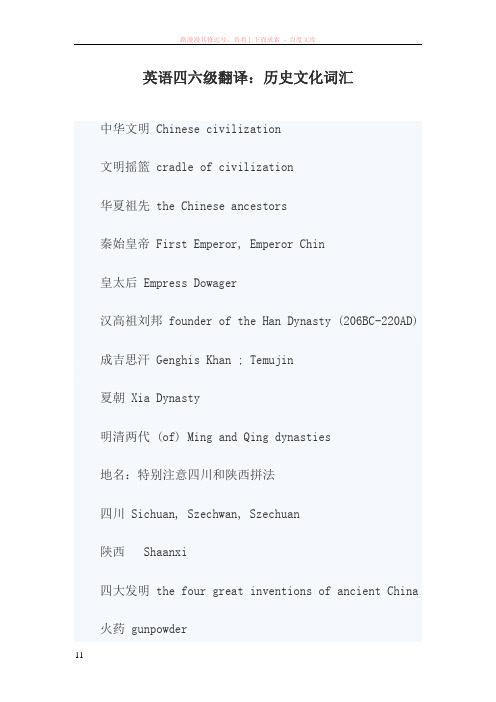
英语四六级翻译:历史文化词汇中华文明 Chinese civilization文明摇篮 cradle of civilization华夏祖先 the Chinese ancestors秦始皇帝 First Emperor, Emperor Chin皇太后 Empress Dowager汉高祖刘邦 founder of the Han Dynasty (206BC-220AD) 成吉思汗 Genghis Khan ; Temujin夏朝 Xia Dynasty明清两代 (of) Ming and Qing dynasties地名:特别注意四川和陕西拼法四川 Sichuan, Szechwan, Szechuan陝西 Shaanxi四大发明 the four great inventions of ancient China 火药 gunpowder印刷术 printing造纸术 paper-making指南针 the compass汉字 Chinese character单音节 single syllable汉语四声调 the four tones of Chinese characters 阳平 level tone阴平 rising tone上声 falling-rising tone去声 falling tone四书 the Four Books《大学》 The Great Learning《中庸》 The Doctrine of the Mean《论语》 The Analects of Confucius《孟子》 The Mencius《春秋》 the Spring and Autumn Annals《史记》 Historical Records《诗经》 The Books of Songs;The Book of Odes《书经》 The Books of History《易经》 I Ching; The Book of Changes《礼记》 The Book of Rites《孝经》 Book of Filial Piety《孙子兵法》 The Art of War《三字经》 The Three-Character Scripture;TheThree-Word Chant《三国演义》 Three Kingdoms《西游记》 Journey to the West; Pilgrimage to the West 《红楼梦》 Dream of the Red Mansions《山海经》 The Classic of Mountains and Rivers《资治通鉴》 History as a Mirror;Comprehensive History Retold as a Mirror for Rulers《西厢记》 The Romance of West Chamber《水浒传》 Heroes of the Marshes; Tales of the Water Margin《聊斋志异》 Strange Tales of a Lonely Studio; Strange Tales from Make-Do Studio《围城》 Fortress Besieged《阿Q正传》 The True Story of Ah Q五言绝句 five-character quatrain七言律诗 seven-character octave八股文 eight-part essay; stereotyped writing重要文化遗产 major cultural heritage优秀民间艺术 outstanding folk arts文物 cultural relics中国画 traditional Chinese painting书法 calligraphy水墨画 Chinese brush painting; ink and wash painting工笔 traditional Chinese realistic painting中国结 Chinese knot旗袍 Cheongsam中山装 Chinese tunic suit唐装 traditional Chinese garments (clothing),Tang suit朝廷使者 royal court envoy文人 men of letters雅士 refined scholars表演艺术 performing art现代流行艺术 popular art, pop art纯艺术 high art高雅艺术 refined art电影艺术 cinematographic art戏剧艺术 theatrical art才子佳人 gifted scholars and beautiful ladies生 (男性正面角色) male (the positive male role)旦 (女性正面角色) female (the positive female role) 净 (性格鲜明的男性配角) a supporting male role with striking character丑 (幽默滑稽或反面角色) a clown or a negative role 花脸 painted role歌舞喜剧 musical滑稽场面, 搞笑小噱头 shtick滑稽短剧 skit京剧人物脸谱 Peking Opera Mask皮影戏 shadow play; leather-silhouette show说书 story-telling叠罗汉 make a human pyramid折子戏 opera highlights踩高跷 stilt walk哑剧 pantomime; mime哑剧演员 pantomimist戏剧小品 skit马戏 circus show单口相声 monologue comic talk, standup comedy特技表演 stunt相声 witty dialogue comedy, comic cross talk杂技 acrobatics京韵大鼓 the traditional story-telling in Beijing dialect with drum accompaniment秦腔 Shaanxi opera武术 martial art功夫 kung fu武术门派 styles or schools of martial art习武健身 practice martial art for fitness气功 qigong, deep breathing exercises拳击 boxing篆刻 seal cutting upriteous工艺, 手艺 workmanship / craftsmanship卷轴 scroll蜡染 batik泥人 clay figure漆画 lacquer painting唐三彩 Trio-colored glazed pottery of the Tang Dynasty 景泰蓝 cloisonné文房四宝 The four stationery treasures of the Chinese study --- a writing brush, an ink stick, an ink stone and paper民间传说 folklores寓言 fable传说 legend神话 mythology古为今用,洋为中用 make the past serve the present and the foreign serve china赋诗 inscribe a poem对对联 matching an antithetical couplet阳历 solar calendar公历 Gregorian calendar阴历 lunar calendar天干 heavenly stem地支 earthly branch闰年 leap year二十四节气 the twenty-four solar terms十二生肖 the twele Chinese zodiac signs本命年 one's year of birth considered in relation to the 12 Terrestrial Branches传统节日 traditional holidays春节 the Spring Festival元宵节 the Lantern Festival (15th day of the first lunar month)清明节 the Pure Brightness Festival / theTomb-sweeping Day (April the 5th)端午节 the Dragon Boat Festival (5th of the fifth lunar month)中秋节 the Moon Festival / the Mid-Autumn Day (15th of the eight lunar month)重阳节 the Double Ninth Day / the Aged Day。
2022年关于中国文化的英语作文_Chinese culture 5篇

关于中国文化的英语作文_Chinese culture 5篇导读:关于”中国文化“的英语作文模板5篇,作文题目:Chinese culture。
以下是关于中国文化的高三英语模板,每篇作文均为真题模板带翻译。
关于”中国文化“的英语作文模板5篇,作文题目:Chinese culture。
以下是关于中国文化的高三英语模板,每篇作文均为真题模板带翻译。
高分英语作文1:Chinese cultureEvery year, the world is paying close attention to the Nobel Prize for literature. The winners will receive both fame and wealth, their writing career reach the peak of Chinese culture. China has a history of thousands of years and many great works are famous in the world.Therefore, why Chinese writers have to go so long to win the Nobel Prize is that English, as an international language, is accepted by the world, Chinese great works need to be translated into English so that they can be read by the judges. But the bad thing is that in the process of translation, the artistic conception is lost to some extent, leaving only the main significance. Therefore, we do not need to question our literature.It is excellent and the world will see it one day.中文翻译:每年,全世界都在关注诺贝尔文学奖,获奖者将名利双收,使自己的写作生涯登上中国文化的巅峰,中国有几千年的历史,有许多伟大的作品闻名于世,所以中国作家为什么要走这么长的路才能获得诺贝尔奖最明显的因素是英语作为国际语言的语言被世界所接受,中国的伟大作品需要翻译成英文,这样才能被评委们阅读,但不好的是,在翻译过程中,意境在某种程度上有所损失,只留下了主要的意义,所以我们不需要质疑我们的文学,它是优秀的,总有一天世界会看到它的。
四六级翻译--中国文化
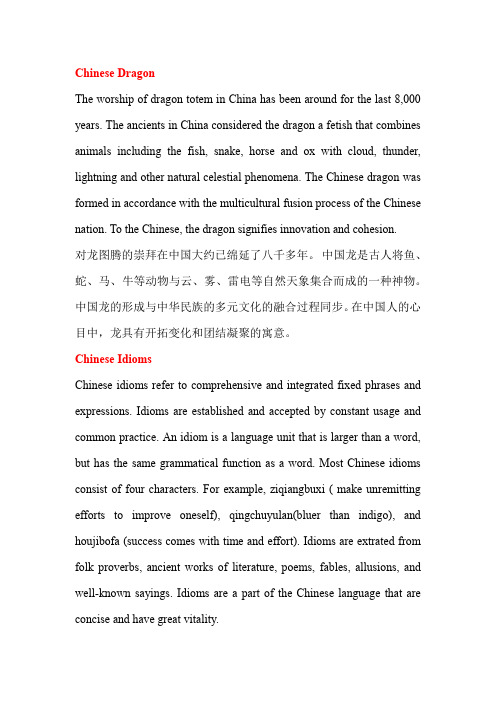
Chinese DragonThe worship of dragon totem in China has been around for the last 8,000 years. The ancients in China considered the dragon a fetish that combines animals including the fish, snake, horse and ox with cloud, thunder, lightning and other natural celestial phenomena. The Chinese dragon was formed in accordance with the multicultural fusion process of the Chinese nation. To the Chinese, the dragon signifies innovation and cohesion.对龙图腾的崇拜在中国大约已绵延了八千多年。
中国龙是古人将鱼、蛇、马、牛等动物与云、雾、雷电等自然天象集合而成的一种神物。
中国龙的形成与中华民族的多元文化的融合过程同步。
在中国人的心目中,龙具有开拓变化和团结凝聚的寓意。
Chinese IdiomsChinese idioms refer to comprehensive and integrated fixed phrases and expressions. Idioms are established and accepted by constant usage and common practice. An idiom is a language unit that is larger than a word, but has the same grammatical function as a word. Most Chinese idioms consist of four characters. For example, ziqiangbuxi ( make unremitting efforts to improve oneself), qingchuyulan(bluer than indigo), and houjibofa (success comes with time and effort). Idioms are extrated from folk proverbs, ancient works of literature, poems, fables, allusions, and well-known sayings. Idioms are a part of the Chinese language that are concise and have great vitality.中国成语是汉语中意义完整的表示一般概念的固定词组或短语。
汉英翻译 中国传统文化
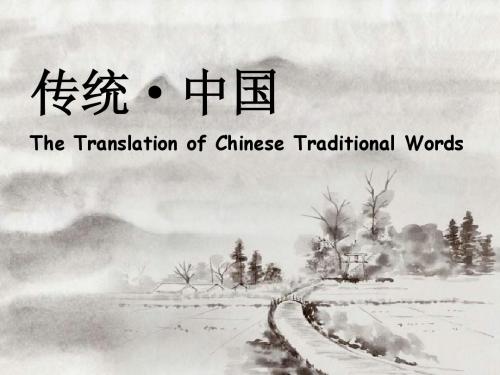
中国电信 China Telecom 中国移动 China Mobile 十五计划 the 10th Five-Year Plan 中国电脑联网 Chinanet 三峡工程 the Three Gorges Project 希望工程 Project Hope 京九铁路 Beijing CKowloon Railway 扶贫工程 Anti-Poverty Project 菜篮子工程 Vegetable Basket Project 温饱工程 Decent-Life Project 安居工程 Economy Housing Project 西部大开发 Go-West Campaign
传统·中国
The Translation of Chinese Traditional Words
八卦 trigram
阴、阳 yห้องสมุดไป่ตู้n, yang
道 Dao(cf. logo) 道 Daoism(Taoism) 江湖(世界) the jianghu World (the traits’ world) e.g. You can’t control everything in a traits’ world. (人在江湖,身不由己)
儒学 Confucianism 世外桃源 Shangri-la or Arcadia 治则兴,乱则衰 Order leads to prosperity and chaos to decline 禅宗 Zen Buddhism 禅 dhyana; dhgaya 混沌 chaos 道 Daosim, the way and its power 四谛 Four Noble Truth 八正道 Eightfold Path 无常 anity 五行说 Theory of Five Elements 无我 anatman 坐禅 metta or transcendental meditation 空 sunyata 虚无 nothingness
常用中国传统文化英文翻译
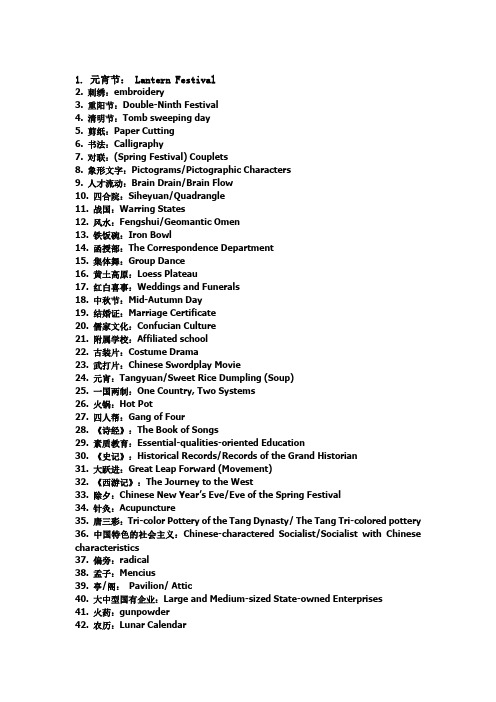
1. 元宵节: Lantern Festival2. 刺绣:embroidery3. 重阳节:Double-Ninth Festival4. 清明节:Tomb sweeping day5. 剪纸:Paper Cutting6. 书法:Calligraphy7. 对联:(Spring Festival) Couplets8. 象形文字:Pictograms/Pictographic Characters9. 人才流动:Brain Drain/Brain Flow10. 四合院:Siheyuan/Quadrangle11. 战国:Warring States12. 风水:Fengshui/Geomantic Omen13. 铁饭碗:Iron Bowl14. 函授部:The Correspondence Department15. 集体舞:Group Dance16. 黄土高原:Loess Plateau17. 红白喜事:Weddings and Funerals18. 中秋节:Mid-Autumn Day19. 结婚证:Marriage Certificate20. 儒家文化:Confucian Culture21. 附属学校:Affiliated school22. 古装片:Costume Drama23. 武打片:Chinese Swordplay Movie24. 元宵:Tangyuan/Sweet Rice Dumpling (Soup)25. 一国两制:One Country, Two Systems26. 火锅:Hot Pot27. 四人帮:Gang of Four28. 《诗经》:The Book of Songs29. 素质教育:Essential-qualities-oriented Education30. 《史记》:Historical Records/Records of the Grand Historian31. 大跃进:Great Leap Forward (Movement)32. 《西游记》:The Journey to the West33. 除夕:Chinese New Year’s Eve/Eve of the Spring Festival34. 针灸:Acupuncture35. 唐三彩:Tri-color Pottery of the Tang Dynasty/ The Tang Tri-colored pottery36. 中国特色的社会主义:Chinese-charactered Socialist/Socialist with Chinese characteristics37. 偏旁:radical38. 孟子:Mencius39. 亭/阁:Pavilion/ Attic40. 大中型国有企业:Large and Medium-sized State-owned Enterprises41. 火药:gunpowder42. 农历:Lunar Calendar43. 印/玺:Seal/Stamp44. 物质精神文明建设:The Construction of Material Civilization and Spiritual Civilization45. 京剧:Beijing Opera/Peking Opera46. 秦腔:Crying of Qin People/Qin Opera47. 太极拳:Tai Chi48. 独生子女证:The Certificate of One-child49. 天坛:Altar of Heaven in Beijing50. 小吃摊:Snack Bar/Snack Stand51. 红双喜:Double Happiness52. 政治辅导员:Political Counselor/School Counselor53. 春卷:Spring Roll(s)54. 莲藕:Lotus Root55. 追星族:Star Struck56. 故宫博物院:The Palace Museum57. 相声:Cross-talk/Comic Dialogue58. 下岗:Lay off/Laid off59. 北京烤鸭:Beijing Roast Duck60. 高等自学考试:Self-taught Examination of Higher Education61. 烟花爆竹:fireworks and firecracker62. 敦煌莫高窟:Mogao Caves63. 电视小品:TV Sketch/TV Skit64. 香港澳门同胞:Compatriots from Hong Kong and Macao65. 文化大革命:Cultural Revolution66. 长江中下游地区:The Mid-low Reaches of Yangtze River67. 门当户对:Perfect Match/Exact Match68. 《水浒》:Water Margin/Outlaws of the Marsh69. 中外合资企业:Joint Ventures70. 文房四宝(笔墨纸砚):"The Four Treasure of the Study" "Brush, Inkstick, Paper, and Inkstone"71. 兵马俑:cotta Warriors/ Terracotta Army72. 旗袍:cheongsam。
中国传统文化 翻译
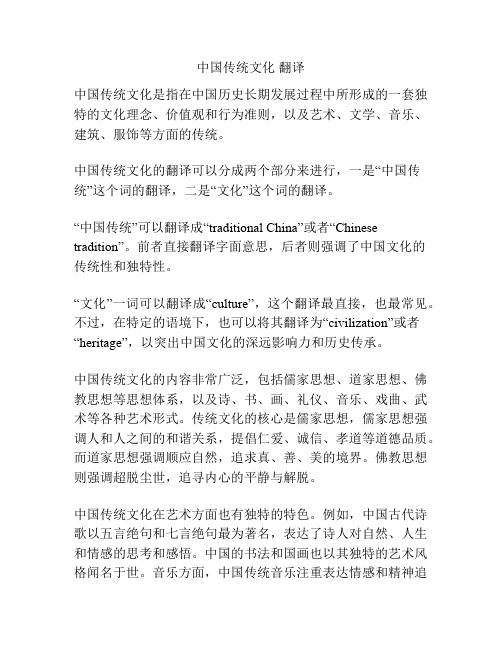
中国传统文化翻译中国传统文化是指在中国历史长期发展过程中所形成的一套独特的文化理念、价值观和行为准则,以及艺术、文学、音乐、建筑、服饰等方面的传统。
中国传统文化的翻译可以分成两个部分来进行,一是“中国传统”这个词的翻译,二是“文化”这个词的翻译。
“中国传统”可以翻译成“traditional China”或者“Chinese tradition”。
前者直接翻译字面意思,后者则强调了中国文化的传统性和独特性。
“文化”一词可以翻译成“culture”,这个翻译最直接,也最常见。
不过,在特定的语境下,也可以将其翻译为“civilization”或者“heritage”,以突出中国文化的深远影响力和历史传承。
中国传统文化的内容非常广泛,包括儒家思想、道家思想、佛教思想等思想体系,以及诗、书、画、礼仪、音乐、戏曲、武术等各种艺术形式。
传统文化的核心是儒家思想,儒家思想强调人和人之间的和谐关系,提倡仁爱、诚信、孝道等道德品质。
而道家思想强调顺应自然,追求真、善、美的境界。
佛教思想则强调超脱尘世,追寻内心的平静与解脱。
中国传统文化在艺术方面也有独特的特色。
例如,中国古代诗歌以五言绝句和七言绝句最为著名,表达了诗人对自然、人生和情感的思考和感悟。
中国的书法和国画也以其独特的艺术风格闻名于世。
音乐方面,中国传统音乐注重表达情感和精神追求,传统乐器如古琴、二胡和琵琶等都有深厚的历史和文化内涵。
中国传统文化的建筑和服饰也是其重要组成部分。
中国古代建筑以其独特的风格和结构,例如宫殿、寺庙、园林等,体现了中国人对自然环境的独特见解和审美理念。
中国传统服饰也有其独特的特色,例如旗袍、汉服等,每一种服饰都代表了不同的历史时期和地域文化。
总之,中国传统文化是中国人民在长期的历史发展过程中所积淀的独特宝藏,它不仅代表了中国人民的智慧和创造力,也具有重要的文化价值和国际影响力。
高中英语 高考英语作文有关中国传统文化的范文5篇带中文翻译
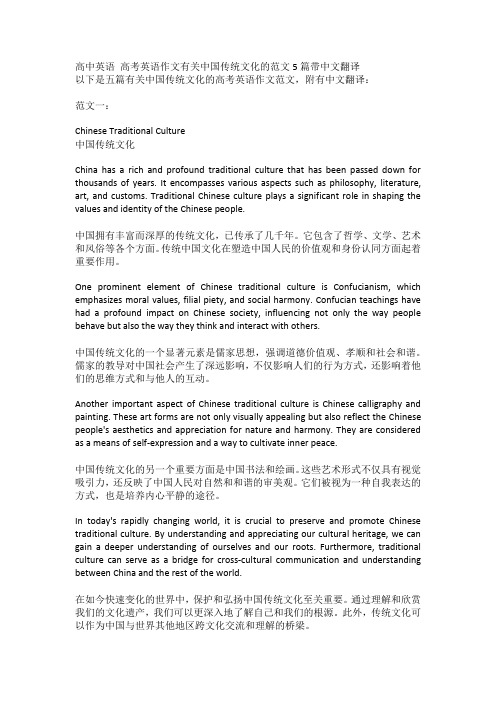
高中英语高考英语作文有关中国传统文化的范文5篇带中文翻译以下是五篇有关中国传统文化的高考英语作文范文,附有中文翻译:范文一:Chinese Traditional Culture中国传统文化China has a rich and profound traditional culture that has been passed down for thousands of years. It encompasses various aspects such as philosophy, literature, art, and customs. Traditional Chinese culture plays a significant role in shaping the values and identity of the Chinese people.中国拥有丰富而深厚的传统文化,已传承了几千年。
它包含了哲学、文学、艺术和风俗等各个方面。
传统中国文化在塑造中国人民的价值观和身份认同方面起着重要作用。
One prominent element of Chinese traditional culture is Confucianism, which emphasizes moral values, filial piety, and social harmony. Confucian teachings have had a profound impact on Chinese society, influencing not only the way people behave but also the way they think and interact with others.中国传统文化的一个显著元素是儒家思想,强调道德价值观、孝顺和社会和谐。
儒家的教导对中国社会产生了深远影响,不仅影响人们的行为方式,还影响着他们的思维方式和与他人的互动。
中国传统文化名称英语翻译
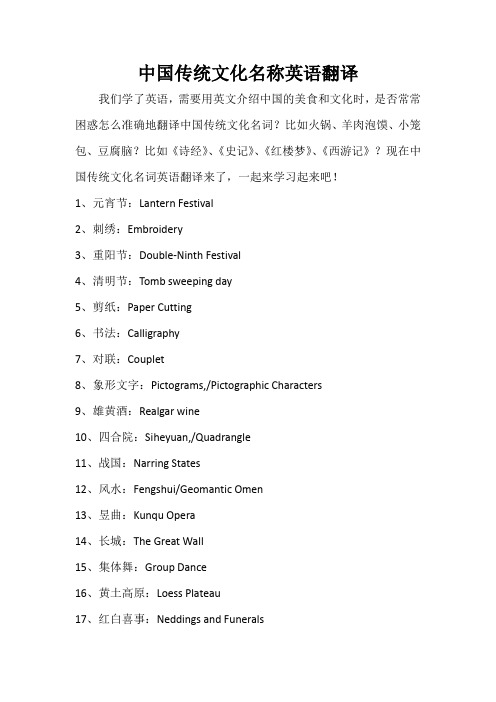
中国传统文化名称英语翻译我们学了英语,需要用英文介绍中国的美食和文化时,是否常常困惑怎么准确地翻译中国传统文化名词?比如火锅、羊肉泡馍、小笼包、豆腐脑?比如《诗经》、《史记》、《红楼梦》、《西游记》?现在中国传统文化名词英语翻译来了,一起来学习起来吧!1、元宵节:Lantern Festival2、刺绣:Embroidery3、重阳节:Double-Ninth Festival4、清明节:Tomb sweeping day5、剪纸:Paper Cutting6、书法:Calligraphy7、对联:Couplet8、象形文字:Pictograms,/Pictographic Characters9、雄黄酒:Realgar wine10、四合院:Siheyuan,/Quadrangle11、战国:Narring States12、风水:Fengshui/Geomantic Omen13、昱曲:Kunqu Opera14、长城:The Great Wall15、集体舞:Group Dance16、黄土高原:Loess Plateau17、红白喜事:Neddings and Funerals18、中秋节:Mid-autumn Day19、花鼓戏:Flower Drum Song2O、儒家文化:Confucian Culture21、中国结:Chinese Knotting22、古装片:Costume Drama23、武打片:Chinese Swordplay Movie24、元宵:Tangyuan/Sweet Rice Dumpling25、越剧:Yue Opera26、火锅:Hot Pot27、江南:South Regions of the Yangtze River28、《诗经》:The Book of Songs29、谜语:Riddle3O、《史记》:Historical Records,/Records of theGrand Historian31、《红楼梦》:A Dream of Red Mansions32、《西游记》:The Journey to the West33、除夕:Chinese New Year’sEve/Eve of theSpring Festival34、针灸:Acupuncture35、唐三彩:Tri-color Pottery of Tang Dynas-ty/The Tang Tri-color Pottery36、二人车转:Errenzhuan37、偏旁:Radical38、孟子:Mencius39、亭/阁:Pavilion/Attic40、黄梅戏:Huangmei opera41、火药:Gunpowder42、农历:Lunar Calendar43、印/玺:Seal/Stamp44、腊八节:The laba Rice Porridge Festival45、京剧:Beijing Opera/Peking Opera46、秦腔:Qin Opera47、太极拳:Tai Chi48、《本草纲目》:Compendium of Materia Medica49、天坛:Temple of Heaven5O、小吃摊:Snack Bar/Snack Stand51、红双喜:Double Happiness52、文房四宝:The Four Treasures of the Study、笔墨纸砚:Brush,Inkstick,Paper,and Inkstone53、春卷:Spring Roll(s)54、莲藕:Lotus Root55、《三国演义》:The Romance of Three Kingdoms56、故宫博物院:The Palace Museum57、相声:Cross-talk/Comic Dialogue58、五行:Five Elements59、北京烤鸭:Beijing Roast Duck60、《桃花扇》:The Peach Blossom Fan61、木偶戏:Puppet Show62、敦煌莫高窟:Mogao Caves63、电视小品:TV Sketch/TV Skit64、甲骨文:Oracle Bone Inscriptions65、古筝:Chinese Zither66、二胡:Urheen67、门当户对:Perfect Match/Exact Match68、《水浒》:Water Margin,/Outlaws of the Marsh69、炸酱面:Noodles with Bean Paste7O、国子监:Imperial Academy71、兵马俑:Cotta Warriors,/Terracotta Army72、旗袍:Cheongsam73、指南针:Compass74、泼水节:Water-Splashing Day75、馄饨:Wonton76、花卷:Steamed twisted rolls77、羊肉泡馍:Pita Bread Soaked in Lamb Soup78、冰糖葫芦:A stick of sugar--coated haws79、八宝饭:Eight--treasure rice pudding80、粉丝:Chinese Vermicelli81、豆腐脑:Jellied bean curd82、小品:Witty Skits83、孝顺:To show filial obedience84、武术:NuShu(Chinese Martial Arts)85、宣纸:Rice Paper86、衙门:Yamen87、叩头:Kowtow88、中庸:The way of medium(cf.Golden Means)89、牌楼:Pailou(pai-loo)90、东坡肉:Dongpo Pork91、中山陵:The Sun Yat--sen Mausoleum92、秦淮河:Qinhuai River93、玄武湖:Xuanwu Lake94、夫子庙:The Confucian Temple95、甲鸭血粉丝:Chinese Vermicelli Cooked withDuck Blood96、盐水鸭:Yanshuiya,or boiled salted duck97、大煮千丝:Raised Shredded Chicken with Hamand Dried Tofu98、小笼包:Steamed buns99、明孝陵:Ming Tomb100、云锦:Nanjing brocade。
中国传统文化词汇中英互译

中国传统文化词汇中英互译1. 元宵节: Lantern Festival2. 刺绣:embroidery3. 重阳节:Double-Ninth Festival4. 清明节:Tomb sweeping day5. 剪纸:Paper Cutting6. 书法:Calligraphy7. 对联:(Spring Festival) Couplets8. 象形文字:Pictograms/Pictographic Characters9. 人才流动:Brain Drain/Brain Flow10. 四合院:Siheyuan/Quadrangle11. 战国:Warring States12. 风水:Fengshui/Geomantic Omen13. 铁饭碗:Iron Bowl14. 函授部:The Correspondence Department15. 集体舞:Group Dance16. 黄土高原:Loess Plateau17. 红白喜事:Weddings and Funerals18. 中秋节:Mid-Autumn Day19. 结婚证:Marriage Certificate20. 儒家文化:Confucian Culture21. 附属学校:Affiliated school22. 古装片:Costume Drama23. 武打片:Chinese Swordplay Movie24. 元宵:Tangyuan/Sweet Rice Dumpling (Soup)25. 一国两制:One Country, Two Systems26. 火锅:Hot Pot27. 四人帮:Gang of Four28. 《诗经》:The Book of Songs29. 素质教育:Essential-qualities-oriented Education30. 《史记》:Historical Records/Records of the Grand Historian31. 大跃进:Great Leap Forward (Movement)32. 《西游记》:The Journey to the West33. 除夕:Chinese New Year’s Eve/Eve of the Spring Festival34. 针灸:Acupuncture35. 唐三彩:Tri-color Pottery of the Tang Dynasty/ The Tang Tri-colored pottery36. 中国特色的社会主义:Chinese-charactered Socialist/Socialist with Chinese characteristics37. 偏旁:radical38. 孟子:Mencius39. 亭/阁: Pavilion/ Attic40. 大中型国有企业:Large and Medium-sized State-owned Enterprises41. 火药:gunpowder42. 农历:Lunar Calendar43. 印/玺:Seal/Stamp44. 物质精神文明建设:The Construction of Material Civilization and Spiritual Civilization45. 京剧:Beijing Opera/Peking Opera46. 秦腔:Crying of Qin People/Qin Opera47. 太极拳:Tai Chi48. 独生子女证:The Certificate of One-child49. 天坛:Altar of Heaven in Beijing50. 小吃摊:Snack Bar/Snack Stand51. 红双喜:Double Happiness52. 政治辅导员:Political Counselor/School Counselor53. 春卷:Spring Roll(s)54. 莲藕:Lotus Root55. 追星族:Star Struck56. 故宫博物院:The Palace Museum57. 相声:Cross-talk/Comic Dialogue58. 下岗:Lay off/Laid off59. 北京烤鸭:Beijing Roast Duck60. 高等自学考试:Self-taught Examination of Higher Education61. 烟花爆竹:fireworks and firecracker62. 敦煌莫高窟:Mogao Caves63. 电视小品:TV Sketch/TV Skit64. 香港澳门同胞:Compatriots from Hong Kong and Macao65. 文化大革命:Cultural Revolution66. 长江中下游地区:The Mid-low Reaches of Yangtze River67. 门当户对:Perfect Match/Exact Match68. 《水浒》:Water Margin/Outlaws of the Marsh69. 中外合资企业:Joint Ventures70. 文房四宝(笔墨纸砚):"The Four Treasure of the Study" "Brush, Inkstick, Paper, and Inkstone"71.兵马俑:cotta Warriors/ Terracotta Army72.旗袍:cheongsam翻译中的黄金词组一、政治类:1. 日益昌盛become increasingly prosperous2. 快速发展develop rapidly3. 隆重集会gather ceremoniously4. 热爱和平love peace5. 追求进步pursue progress6. 履行权利和义务perform the responsibilities and obligations7. 回顾奋斗历程review the course of struggle8. 展望伟大征程look into the great journey9. 充满信心和力量be filled with confidence and strength10. 必胜be bound to win11. 主张各国政府采取行动urge governments of all countries to takeaction12. 和平共处coexist peacefully13. 对内开放和对外开放open up both externally and internally14. 经历两个不同时期experience two different periods15. 战胜无数的困难overcome numerous difficulties16. 赢得一个又一个胜利win one victory after another17. 完全意识到be fully aware that18. 迈出重要的一步make an important step19. 采取各种措施adopt various measures20. 得出结论,告一段落draw ( arrive at, come to reach ) a conclusion21. 实现民族独立realize national independence22. 追求真理seek the truth23. 建立社会主义制度establish a socialist system24. 根除(防止,消除)腐败root out (prevent, eliminate) corruption25. 响应号召respond to the call26. 进入新时期enter a new period27. 实行新政策practice new policies28. 展现生机和活力display one’s vigor and vitality29. 增强综合国力enhance comprehensive(overall) national strength and和国际竟争力international competitiveness30. 进入世界先进行列edge into the advanced ranks in the world31. 解决温饱问题solve the problem of food and clothing32. 吸收各国文明的先进成果absorb what is advanced in other civilizations33. 与日俱增increase every day34. 实现夙愿fulfill the long-cherished wishes35. 必将实现be bound to come true36. 锻造一支人民军队forge a people’s army37. 建立巩固的国防build a strong national defense38. 进行和谈hold peace talks39. 修改法律amend the laws40. 在...中起(至关)play a major的(crucial, an important ) role in重要作用41. 对...做出重要(巨大)贡献make important (great, major )contributions to42. 遵循规则follow the principles43. 把理论和实际结合起来integrate theory with practice …44. 把...作为指导take… as the guide45. 缓和紧张状况ease the tension46. 高举伟大旗帜hold high the great banner47. 解决新问题resolve new problems48. 观察当今世界observe the present-day world49. 开拓前进open up new ways forward50. 增强凝聚力enhance the rally power51. 结束暴力,开始和平谈判end the violence and resume peace talks52. 进行战略性调整make strategic readjustment53. 开始生效go into effect / enter into force54. 就...接受妥协accept a compromise on55. 接受...的采访be interviewed by56. 把……看成社会公敌look upon … as a threat to society57. 把……捐给慈善机构donate …to charities58. 维护世界和平maintain world peace59. 摆脱贫穷落后get rid of poverty and backwardness60. 实现发展繁荣bring about development and prosperity61. 反对各种形式的恐怖主义be opposed to all forms of terrorism62. 宣布。
中国传统文化中英文翻译
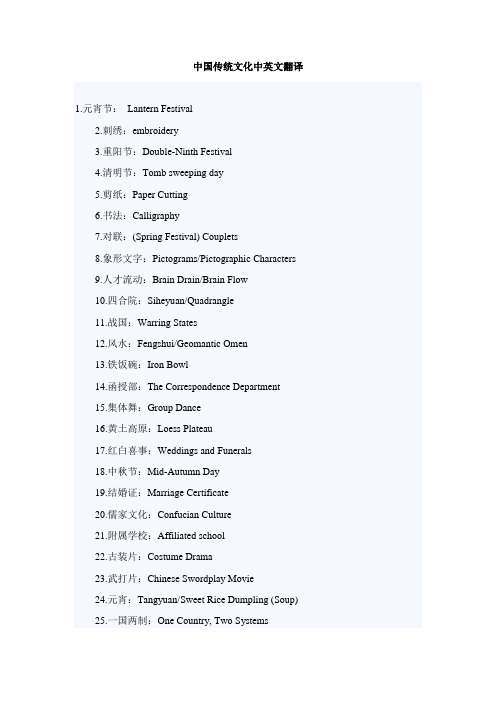
中国传统文化中英文翻译1.元宵节:Lantern Festival2.刺绣:embroidery3.重阳节:Double-Ninth Festival4.清明节:Tomb sweeping day5.剪纸:Paper Cutting6.书法:Calligraphy7.对联:(Spring Festival) Couplets8.象形文字:Pictograms/Pictographic Characters9.人才流动:Brain Drain/Brain Flow10.四合院:Siheyuan/Quadrangle11.战国:Warring States12.风水:Fengshui/Geomantic Omen13.铁饭碗:Iron Bowl14.函授部:The Correspondence Department15.集体舞:Group Dance16.黄土高原:Loess Plateau17.红白喜事:Weddings and Funerals18.中秋节:Mid-Autumn Day19.结婚证:Marriage Certificate20.儒家文化:Confucian Culture21.附属学校:Affiliated school22.古装片:Costume Drama23.武打片:Chinese Swordplay Movie24.元宵:Tangyuan/Sweet Rice Dumpling (Soup)25.一国两制:One Country, Two Systems26.火锅:Hot Pot27.四人帮:Gang of Four28.《诗经》:The Book of Songs29.素质教育:Essential-qualities-oriented Education30.《史记》:Historical Records/Records of the Grand Historian31.大跃进:Great Leap Forward (Movement)32.《西游记》:The Journey to the West33.除夕:Chinese New Year’s Eve/Eve of the Spring F estival34.针灸:Acupuncture35.唐三彩:Tri-color Pottery of the Tang Dynasty/ The Tang Tri-colored pottery36.中国特色的社会主义:Chinese-charactered Socialist/Socialist with Chinese characteristics37.偏旁:radical38.孟子:Mencius39.亭/阁:Pavilion/ Attic40.大中型国有企业:Large and Medium-sized State-owned Enterprises41.火药:gunpowder42.农历:Lunar Calendar43.印/玺:Seal/Stamp44.物质精神文明建设:The Construction of Material Civilization and Spiritual Civilization45.京剧:Beijing Opera/Peking Opera46.秦腔:Crying of Qin People/Qin Opera47.太极拳:Tai Chi48.独生子女证:The Certificate of One-child49.天坛:Altar of Heaven in Beijing50.小吃摊:Snack Bar/Snack Stand51.红双喜:Double Happiness52.政治辅导员:Political Counselor/School Counselor53.春卷:Spring Roll(s)54.莲藕:Lotus Root55.追星族:Star Struck56.故宫博物院:The Palace Museum57.相声:Cross-talk/Comic Dialogue58.下岗:Lay off/Laid off59.北京烤鸭:Beijing Roast Duck60.高等自学考试:Self-taught Examination of Higher Education61.烟花爆竹:fireworks and firecracker62.敦煌莫高窟:Mogao Caves63.电视小品:TV Sketch/TV Skit64.香港澳门同胞:Compatriots from Hong Kong and Macao65.文化大革命:Cultural Revolution66.长江中下游地区:The Mid-low Reaches of Yangtze River67.门当户对:Perfect Match/Exact Match68.《水浒》:Water Margin/Outlaws of the Marsh69.中外合资企业:Joint Ventures70.文房四宝(笔墨纸砚):"The Four Treasure of the Study" "Brush, Inkstick, Paper, and Inkstone"71.兵马俑:cotta Warriors/ Terracotta Army。
传统中国文化八大主题中英翻译

中国传统文化Traditional Chinese Culture1 书法艺术The Art of Calligraphy2 中国画的含意The Significance of Chinese Paintings3 重新发现孔子Rediscover Confucius4中医和西医的差异Differences between Chinese and Western Medicines5 戏曲的作用The Role of Operas6中国人崇尚的颜色:黄和红China’s Favorite Colo r: Yellow & Red:7筷子的重要性The Importance of Chopsticks8 茶的格调The Elegance of Tea Drinking1. 书法艺术The Art of Calligraphy有批评家指出,不同的书法风格有不同的政治寓意。
拿王羲之的书体来说。
他的书法在他有生之年被批评为非正统的书体,然而在他去世几十年之后又被认为是正统的书体。
Some critics suggest that different genres of Chinese calligraphy have different political implications. Take Wang Xizhi for an example. His calligraphy was repudiated as unorthodox during his lifetime but, only a few decades after his death, was established as an orthodox genre.从历史上看,中国书法和政治紧密相连。
2000多年前,秦始皇建立了官方的汉字体系。
新的简化文字使得书法不那么复杂了。
它允许人们使用带有更多直笔的文字,因此用毛笔写起来更加容易。
高中英语 高考英语作文有关中国传统文化的范文5篇带中文翻译
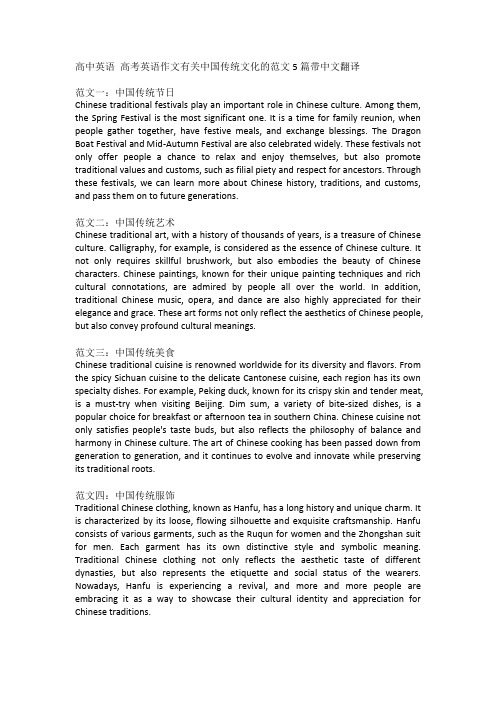
高中英语高考英语作文有关中国传统文化的范文5篇带中文翻译范文一:中国传统节日Chinese traditional festivals play an important role in Chinese culture. Among them, the Spring Festival is the most significant one. It is a time for family reunion, when people gather together, have festive meals, and exchange blessings. The Dragon Boat Festival and Mid-Autumn Festival are also celebrated widely. These festivals not only offer people a chance to relax and enjoy themselves, but also promote traditional values and customs, such as filial piety and respect for ancestors. Through these festivals, we can learn more about Chinese history, traditions, and customs, and pass them on to future generations.范文二:中国传统艺术Chinese traditional art, with a history of thousands of years, is a treasure of Chinese culture. Calligraphy, for example, is considered as the essence of Chinese culture. It not only requires skillful brushwork, but also embodies the beauty of Chinese characters. Chinese paintings, known for their unique painting techniques and rich cultural connotations, are admired by people all over the world. In addition, traditional Chinese music, opera, and dance are also highly appreciated for their elegance and grace. These art forms not only reflect the aesthetics of Chinese people, but also convey profound cultural meanings.范文三:中国传统美食Chinese traditional cuisine is renowned worldwide for its diversity and flavors. From the spicy Sichuan cuisine to the delicate Cantonese cuisine, each region has its own specialty dishes. For example, Peking duck, known for its crispy skin and tender meat, is a must-try when visiting Beijing. Dim sum, a variety of bite-sized dishes, is a popular choice for breakfast or afternoon tea in southern China. Chinese cuisine not only satisfies people's taste buds, but also reflects the philosophy of balance and harmony in Chinese culture. The art of Chinese cooking has been passed down from generation to generation, and it continues to evolve and innovate while preserving its traditional roots.范文四:中国传统服饰Traditional Chinese clothing, known as Hanfu, has a long history and unique charm. It is characterized by its loose, flowing silhouette and exquisite craftsmanship. Hanfu consists of various garments, such as the Ruqun for women and the Zhongshan suit for men. Each garment has its own distinctive style and symbolic meaning. Traditional Chinese clothing not only reflects the aesthetic taste of different dynasties, but also represents the etiquette and social status of the wearers. Nowadays, Hanfu is experiencing a revival, and more and more people are embracing it as a way to showcase their cultural identity and appreciation for Chinese traditions.范文五:中国传统建筑Chinese traditional architecture, with its distinctive style and profound cultural connotations, is a true representation of Chinese culture. The Forbidden City in Beijing, with its grandeur and meticulous design, is a masterpiece of traditional Chinese architecture. The classical gardens in Suzhou, known for their harmonious layout and exquisite details, showcase the perfect integration of nature and human creations. Traditional Chinese architecture also emphasizes the balance of Yin and Yang, and the harmony between man and nature. It is not only a manifestation of architectural skills, but also a reflection of the wisdom and philosophy of the Chinese people.范文一:中国传统节日中国传统节日在中国文化中占有重要地位。
中国文化英语作文模板带翻译初一

中国文化英语作文模板带翻译初一Chinese Culture。
Chinese culture, one of the oldest and richest cultures in the world, is a source of pride for the Chinese people. With a history of over 5,000 years, it has been greatly influential in shaping the culture of East Asia, and it continues to have a profound impact on the world today.Chinese culture is characterized by its diversity and richness. It encompasses a wide range of traditions, customs, and practices that have been passed down from generation to generation. From the ancient philosophy of Confucianism to the traditional Chinese medicine, from the exquisite art of calligraphy to the vibrant celebrations of Chinese New Year, Chinese culture is a treasure trove of wisdom, beauty, and tradition.One of the most distinctive features of Chinese culture is its emphasis on harmony and balance. This is reflected in various aspects of Chinese life, from the principles of yin and yang in traditional Chinese medicine to the concept of the Five Elements in Chinese philosophy. The Chinese also place great importance on the harmony between humans and nature, which is evident in practices such as feng shui and tai chi.Another key aspect of Chinese culture is its strong sense of family and community. Family is considered the foundation of society, and filial piety is a core value in Chinese culture. Respect for elders, caring for one's parents, and maintaining strong family ties are all highly valued in Chinese society. In addition, the concept of guanxi, or personal connections, plays a crucial role in Chinese social interactions and business dealings.The arts have always been an integral part of Chinese culture, and they continue to thrive today. Chinese literature, with its rich tradition of poetry, prose, and drama, has produced some of the world's most enduring literary classics. Chinese painting and calligraphy, with their emphasis on brushwork and symbolism, are admired for their elegance and expressiveness. Chinese music, with its distinctive instruments and melodies, is celebrated for its beauty and emotional depth.Chinese cuisine, with its diverse flavors and regional specialties, is another important aspect of Chinese culture. From the fiery dishes of Sichuan to the delicate dim sum of Guangdong, Chinese food is renowned for its variety and complexity. The traditional Chinese tea culture, with its elaborate tea ceremonies and rituals, is also an integral part of Chinese culinary heritage.In recent years, Chinese culture has gained increasing recognition and popularity around the world. Chinese language and literature, traditional Chinese medicine, martial arts, and Chinese cuisine have all found enthusiastic audiences in many countries. The global appeal of Chinese culture is a testament to its enduring vitality and relevance in the modern world.In conclusion, Chinese culture is a rich and multifaceted tapestry that reflects the wisdom, beauty, and traditions of one of the world's oldest civilizations. Its influence can be seen in every aspect of Chinese life, from philosophy and art to cuisine and social customs. As China continues to play an increasingly important role on the world stage, its culture will undoubtedly continue to captivate and inspire people around the globe.。
中国文化英语教程unit3原文翻译程筱棠

中国文化英语教程unit3原文翻译程筱棠中国文化英语教程Unit 3原文翻译Unit 3: The Chinese LanguageIntroduction:China is a vast country with a long history and a rich cultural heritage. One of the most significant aspects of Chinese culture is the Chinese language. In this unit, wewill explore the Chinese language and its unique features.Chinese Characters:The Chinese language is written using Chinese characters. Each character represents a distinct concept or idea, and there are over 50,000 characters in total. Learning Chinese characters is a challenging task, but it is essential to understanding and reading Chinese texts.Pinyin:Pinyin is a Romanized phonetic system used to represent the pronunciation of Chinese characters. It was created in the 1950s to help foreigners learn and pronounce Chinese words. Pinyin uses the Roman alphabet and tone marks to indicate the tones of each syllable.Tones:Chinese is a tonal language, which means that the tone or pitch of a word can change its meaning. There are four main tones in Mandarin Chinese: the first tone (high and level), the second tone (rising), the third tone (low and falling-rising), and the fourth tone (falling).Radicals:Radicals are the building blocks of Chinese characters. They are character components that contribute to both the meaning and pronunciation of a character. Understanding radicals can help learners guess the meanings of unfamiliar characters.Grammar:Chinese grammar is relatively simple compared to Western languages. Chinese sentences follow a subject-verb-object word order, and there are no grammatical gender or articles. Verbs do not conjugate based on tense or person, but time expressions or context help clarify the time or person.Idioms:Chinese idioms, also known as chengyu, are a group of commonly used four-character expressions. Idioms often have a unique historical or cultural background and convey profound meanings. Learning idioms is an effective way to deepen one's understanding of Chinese culture and language.Characters in Action:Characters in Chinese culture often convey deeper meanings and symbolize various concepts. For example, the character for "love" (爱) represents two people, showing theconcept of affection between individuals. Understanding the cultural connotations of characters can enhance one's comprehension of Chinese language and culture.Cultural Notes:Learning the Chinese language involves more than just vocabulary and grammar. It is also important to be aware of cultural nuances and customs. For example, addressing someone by their full name is considered polite in China, and using their given name alone can be disrespectful.双语例句:1. Chinese characters are the building blocks of the Chinese language. (汉字是汉语的基石。
- 1、下载文档前请自行甄别文档内容的完整性,平台不提供额外的编辑、内容补充、找答案等附加服务。
- 2、"仅部分预览"的文档,不可在线预览部分如存在完整性等问题,可反馈申请退款(可完整预览的文档不适用该条件!)。
- 3、如文档侵犯您的权益,请联系客服反馈,我们会尽快为您处理(人工客服工作时间:9:00-18:30)。
Unit1 中国丝绸中国是丝绸的故乡。
栽桑、养蚕、缫丝、织绸是中国古代人民的伟大发明。
商周时期(前1600——前256)丝绸的生产技术就已发展到相当高的水平。
西汉(前206——公元25)时张蹇通西域,把中元与波斯湾、地中海紧密联系起来,开辟了中外交流贸易的新纪元。
从此中国的丝绸以其卓越的品质、精美的花色和丰富的文化内涵闻名于世,成为中国文化的象征、东方文明的使者。
Chinese SilkChina is the home of silk. Mulberry planting, sericulture, silk reeling and thickening are all great inventions of the ancient Chinese. As early as the Shang and Zhou Dynasties (1600-BC256BC), the Chinese people’s silk-weaving techniques had reached an extremely high level. During the Western Han Dynasty(206BC-25AD),Zhang Jian ,an outstanding diplomat ,traveled around central Asia and connected China with the Persian Gulf and the Mediterranean, opening up a new era of Sino-foreign trade, exchange and communication. From then on, China’s silk became well known for its extraordinary quality, exquisite design and color , and abundant cultural connotations. Hitherto, Chinese silk has been accepted as a symbol of Chinese culture and the emissary of oriental civilization.Unit 2 中国园林中国园林是把人造的山水、植物、建筑等与自然地貌有机结合的环境艺术,是我国古代建筑艺术的珍宝。
其建造原则是“妙极自然,宛自天开”。
游赏中国古典园林,能充分领略“假自然之景,创山水真趣”的园林意境。
在世界三大园林体系中,中国园林历史悠久、内涵丰富,被誉为世界造园史上的渊源之一。
Chinese Classical GardenThe Chinese classical garden is a precious treasure of our ancient Chinese architecture. It is a kind of environment art, which systematically combines artificial mountains and rivers, plants and buildings with the natural landscape. The construction standard of a Chinese classical garden is “artificial as it is, the garden must look ingenious and natural.” When you go sightseeing in a Chinese classical garden, you should be able to appreciate its artistic concept which “makes use of the natural landscape to create the real fun of mountains and rivers foe viewers.”Of the world’s three major garden systems, the Chinese classical garden is hailed as one of the origins of the world’s garden due to its long history and abundant connotations.Unit3 文房四宝笔墨纸砚是中国古时文人书房当中必备的宝贝,被称为“文房四宝”。
用笔墨书写绘画在中国可追溯到五千年前。
秦(前221——前206)时已用不同硬度的毛和竹管制笔;汉代(前206——公元220)以人工制墨代替了天然墨;有了纸张以后,简牍锦帛逐失使用;砚台则随笔墨的使用而发展。
“文房四宝”到宋朝(960——1279)以后特指湖笔(浙江湖州)、徽墨(安徽徽州)、宣纸(安徽宣州)、端砚(广东肇庆,古称端州)。
可以说文房四宝书写了整个中华文明。
The Four Treasures of the StudyThe writing brush, inkstick, inkstone, and paper were requisite treasures in the study of the scholars of ancient China, and they are often referred to as the “Four Treasures of the Study.” The writing brush and inkstick have been used by the Chinese to write and paint since 5,000 years ago. In the Qin Dynasty(221BC-206BC),people already used feathers of different hardness and bamboo trunks to make brushes. During the Han Dynasty(206BC-220AD), man-made ink was used instead of natural ink. After paper was invented by the Chinese , bamboo slips, wooden tables, brocade and silk, which originally functioned as writing surfaces, gradually faded out. The inkstone was first developed with the use of writing brushes and ink. After the Song Dynasty(960AD-1279AD),the “Four Treasures of the Study”particularly referred to hubi, the writing brush produced in Huzhou, Zhejiang province; huimo, the inkstick produced in Huizhou, Anhui province ; xuan paper, a kind of paper produced in Xuanzhou, Anhui province and duanyan, the inkstone made in Zhaoqing, Guangdong province (Zhaoqing was earlier called Duanzhou). Indeed, the “Four Treasures of the Study ” have written the whole Chinese civilization, as it is.Unit 4 对联对联又称楹联或对子,是依中文语言一字一音的特征撰写的一种民族文体。
中国对联的哲学深渊及深层民族文化心理,乃是古代中国人把握和认识事物的阴阳二元观念。
对联的特征是“对仗”:字数相等,词性相同,平仄相合,内容相关,节奏相应。
对联习俗多样,有春联、婚联、寿联、挽联、茶联等。
Antithetical CoupletsThe antithetical couplet(also called duilian) is also known as yinglian or duilian. An antithetical couplet is kind of national writing style, which is composed by the skillful manipulation of the characteristic of the Chinese language that one character corresponds with one syllable. The philosophical origin and national cultural psychology of the antithetical couplet are the notion of yin-yang duality, according to which the Chinese recognize and master things. The feature of the antithetical couplet is an “antithesis”: equal characters, the same part of speech, the level and oblique fitting with each other, the contents being related, and the rhythms corresponding. There are many types of antithetical couplets, such as Spring Festival couplets, marriage couplets, birthday couplets, elegiac couplets, and antithetical about tea, etc.Unit 5 中国围棋中国古代四大艺术“琴棋书画”的“棋”特指围棋。
围棋可谓中国的国棋。
